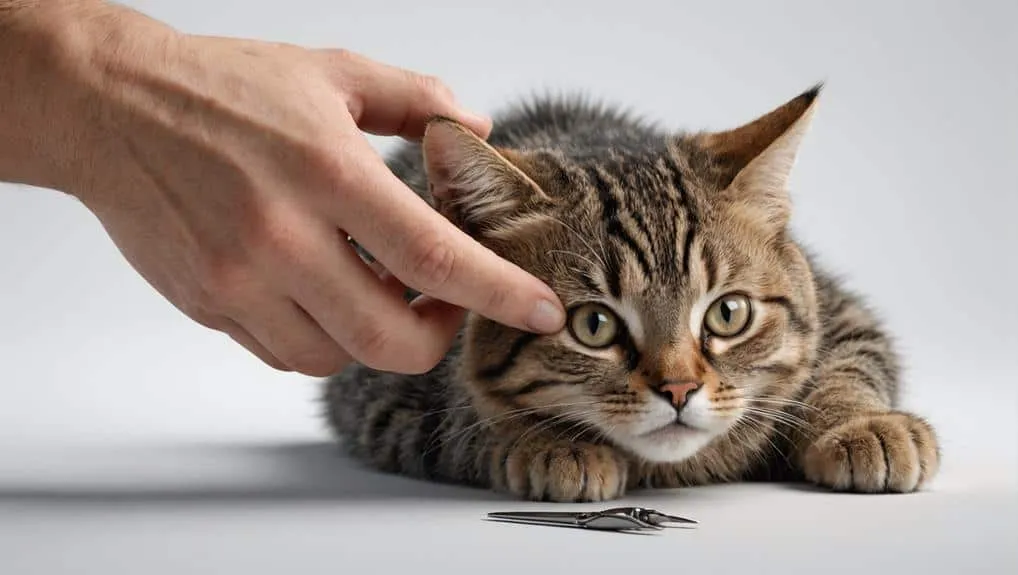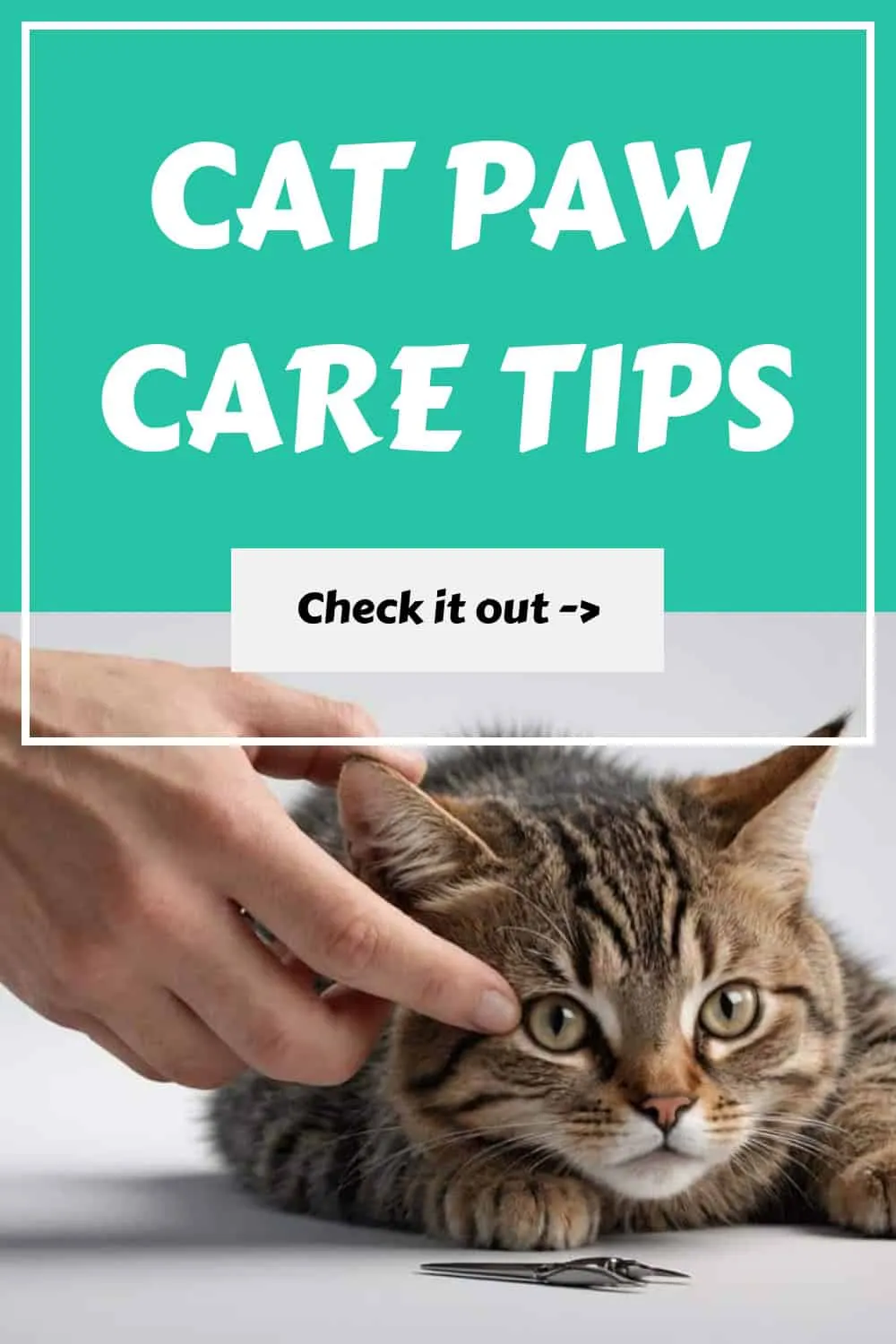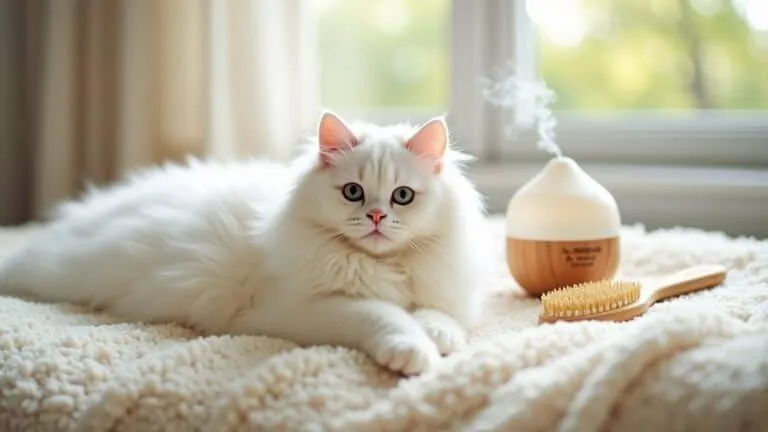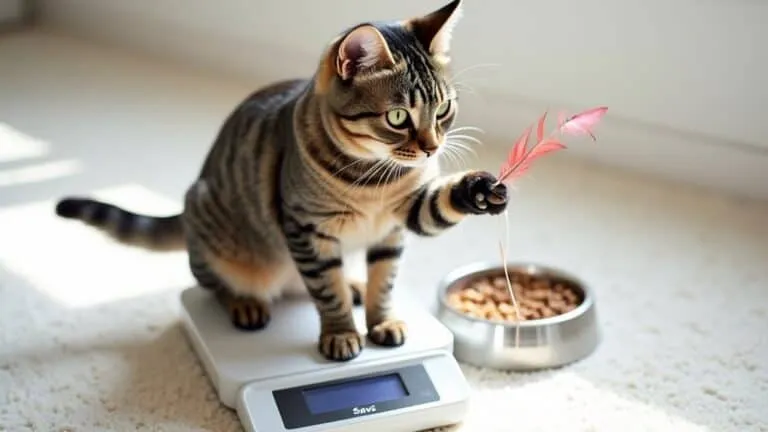The Best Fluffy Pancakes recipe you will fall in love with. Full of tips and tricks to help you make the best pancakes.

So you want to keep your cat's paws healthy and happy. That makes sense!
Regular grooming is key. You should brush your cat's paws weekly to remove loose hair and dirt. Don't overdo it on the baths, though – those can strip their natural oils.
Next, you'll want to trim your cat's nails every 10-14 days. This prevents overgrowth, which can be painful for them. While you're at it, take a closer look at their paws for any injuries or foreign objects. You don't want anything getting stuck in there!
To make the whole experience more enjoyable for your cat, create a calm environment. Handle them gently, keep the lighting soft, and try to minimize noise.
By following these simple cat paw care tips, you'll be promoting overall skin health and catching any potential issues early on. And that's not all – there's even more to learn when you dig deeper!
Grooming Essentials for Healthy Skin
Grooming is a crucial part of keeping your cat's skin and overall health in top shape. Regular sessions can make all the difference. As a responsible cat owner, you should make grooming a priority.
First things first, brushing is essential. You should brush your cat one to two times a week to reduce shedding and prevent matting. This helps keep their coat clean and distributes natural oils evenly. Think of it as a way to give your cat a healthy glow!
When it comes to bathing, less is more. Only bathe your cat when it's absolutely necessary, as excessive washing can strip their coat of natural oils, leading to dry skin. And when you do bathe them, use hypoallergenic products to minimize the risk of skin allergies and irritation.
During grooming, take a closer look at your cat's nails and skin. Check for any signs of issues, like excessive scratching or redness, which could be signs of underlying health problems.
Identifying Skin Problems and Symptoms
When you're examining your cat's skin, there are certain signs you should look out for that might indicate a problem.
One thing to watch for is skin lesions and ulcers. These can be a sign of an underlying issue that needs attention.
You should also be on the lookout for redness and inflammation, which can be a sign of something going on beneath the surface.
Additionally, check for crusting and scaling. These can be signs of a range of skin problems that need to be addressed.
Skin Lesions and Ulcers
So you want to keep an eye out for skin lesions and ulcers in your cat. These can be signs of underlying issues that need prompt veterinary attention.
Skin lesions can show up as scabs, redness, bald patches, or round, scaly areas. These signal potential problems that need to be addressed. If you notice your cat is limping or displaying excessive licking or scratching, you should investigate further.
Ulcers usually appear as open sores on the skin, which may be accompanied by symptoms like excessive licking and scratching. This often suggests an allergic reaction or infection. Changes in skin texture, including flaky or dry skin, can also point to dermatological problems.
If you notice any unusual skin changes, don't hesitate to seek veterinary care. Persistent scratching or biting at a particular area can lead to secondary infections, making timely intervention significant.
Regular examinations are crucial to detect skin lesions and ulcers early, ensuring the best possible treatment outcomes and overall health for your cat. By staying vigilant, you can help your cat receive the care they need to thrive.
Redness and Inflammation Signs
If you notice redness and inflammation around your cat's paw pads, it's a sign that something's not right. This could be due to irritation, infection, or an allergic reaction, and you should investigate the cause right away.
Your cat might be licking or chewing their paws excessively because they're uncomfortable, which can make existing skin issues worse and lead to more inflammation.
Swollen paw pads can be a sign of underlying problems like an abscess or an inflammatory response to something foreign in their paw. If the redness is accompanied by heat or a bad smell, it could mean a bacterial infection or some other serious condition that needs immediate veterinary attention.
Regularly checking your cat's paw pads for changes in color or texture can help you catch inflammation early, which means you can get them treated before things get worse.
Crusting and Scaling Issues
Crusting and scaling on your cat's paw pads or skin is a red flag that something's not quite right. It could be a sign of fungal infections, allergies, or even pesky parasites like fleas and mites.
If you notice crusting or scaling, keep a close eye on your cat's behavior and look for other symptoms like excessive scratching or licking, which can lead to secondary infections.
So, what're some common signs of crusting and scaling issues?
Round, scaly patches could be a sign of ringworm, a contagious fungal infection that needs prompt veterinary attention.
Dry, flaky skin might be due to environmental factors like low humidity or a poor diet, which highlights the importance of keeping your cat hydrated and well-fed to maintain healthy skin.
And if you notice your cat's fur becoming dull or thin, it may be time for a trip to the vet to rule out any underlying skin problems.
Managing Skin Health and Hygiene
Regularly checking your cat's skin can help you catch any potential issues early on, like excessive scratching, redness, or scabs. These could be signs of underlying health problems or parasites.
To keep your cat's skin healthy, start by doing regular inspections to identify any potential issues early on. When cleaning your cat's paws, use products that won't irritate their skin.
A balanced diet with essential fatty acids is also important for healthy skin and a shiny coat. This can help prevent dryness and irritation.
Regular grooming sessions are also a must. Brush your cat regularly to remove loose fur and debris, and bathe them when necessary. This can help prevent matting and skin issues that come with poor hygiene.
Finally, keep your home clean by vacuuming and removing allergens. This can help reduce the risk of skin reactions and create a healthier environment for your cat.
Diagnostic Tests and Veterinary Care
When it comes to taking care of your cat's paws, it's essential to know when to seek professional help. If you notice something's off, don't hesitate to take your cat to the vet.
Veterinary examinations and skin biopsy analysis are two diagnostic tests that can help identify potential issues early on. By being aware of these tests, you'll be better equipped to address any problems that arise and ensure your cat receives the best possible care.
Diagnostic Tests
When it comes to evaluating your cat's paw health, diagnostic tests are crucial in identifying underlying issues that may not be immediately apparent during routine visual examinations. These tests can detect foreign objects, cuts, or signs of infection that may not be visible to the naked eye.
So, how do you get a thorough picture of your cat's paw health? The following diagnostic tests may be necessary.
First, blood tests can assess your cat's overall health and may reveal underlying conditions that could manifest as paw-related issues, such as circulatory or immune system problems.
If your cat has persistent skin problems affecting the paw pads, skin biopsies may be conducted for a definitive diagnosis. This helps distinguish between benign conditions versus more serious issues.
Lastly, bacterial cultures can identify any underlying infections or sources of irritation if abnormalities are noted during routine examinations.
Veterinary Examination
Regular veterinary examinations are crucial for your cat's paw health. By scheduling these check-ups, you can detect potential issues before they become severe. These examinations are vital for identifying underlying health conditions and paw-related issues that may not be immediately apparent.
So, what happens during these examinations? The vet will assess your cat's overall health and evaluate any signs of pain or discomfort in their paws. If your cat is experiencing chronic paw issues, the vet may recommend additional diagnostic tests to determine the underlying cause.
These diagnostic tests can include:
| Diagnostic Tests | Purpose |
|---|---|
| Bacterial cultures | Identify infections |
| Skin scrapings | Check for parasites |
| X-rays | Assess for fractures or abnormalities |
| Blood tests | Rule out systemic conditions |
| Physical examination | Reveal signs of pain or discomfort |
Skin Biopsy Analysis
If your veterinarian suspects an underlying skin condition or infection is affecting your cat's paw health, they may recommend a skin biopsy analysis. This involves taking a small sample of skin tissue for microscopic analysis to identify the cause of skin conditions or abnormalities.
The procedure is usually done under sedation to ensure your cat's comfort and minimize movement during the biopsy collection. The tissue samples are then sent to a veterinary pathologist, who examines them under a microscope and provides a detailed report on the findings, including any signs of cancer.
After the biopsy, it's essential to follow up with your veterinarian. They'll need to monitor for any complications, interpret the results, and discuss potential treatment options based on the diagnosis.
A skin biopsy can help diagnose various issues, such as infections, inflammatory skin diseases, and tumors. This allows for more targeted treatment plans.
The Importance of Regular Brushing
Regular brushing is super important for your cat's overall health and well-being. By brushing them regularly, you'll remove loose hair, dirt, and debris from their coat. This prevents matting and reduces shedding by up to 90% in some cases, keeping their coat looking healthy and shiny.
Brushing also does wonders for your cat's skin. It stimulates the skin's natural oils, promoting a healthy coat and reducing the risk of skin issues.
So, how often should you brush your cat? It's recommended to brush them at least once a week, but if you have a long-haired breed, they may need daily grooming to prevent tangles and discomfort.
Regular brushing sessions can also bring you and your cat closer together. It's a great opportunity for interaction and positive reinforcement through treats.
Plus, consistent grooming lets you detect any potential skin problems or parasites early on, so you can get your cat the care they need from a veterinarian in a timely manner.
Nail Trimming and Paw Care Techniques
Proper nail trimming and paw care are super important for your cat's overall health. If you don't take care of their nails, they can get overgrown, which can lead to painful fractures or ingrown nails. And if you neglect their paws, they can get dirty, injured, or even have stuff stuck between their toes.
To avoid all this, you need to get into a routine of trimming your cat's nails and checking their paws regularly.
So, how do you do it?
Trim regularly – you should trim your cat's nails every 10-14 days. This will stop them from getting too long and reduce the risk of fractures or ingrown nails.
Use the right tools – get yourself some cat-specific nail clippers that are sharp and safe. These will give you a clean cut without hurting your cat.
Inspect and reward – gently press the paw pad to get the claws to come out, which makes it easier to trim them. Give your cat some treats to make them feel good about the trimming session. While you're at it, take a close look at their paws to check for any injuries, dirt, or stuff stuck between their toes.
Creating a Calm Grooming Environment
Creating a calm grooming environment is a great way to reduce your cat's stress levels and make nail trimming and paw care a more enjoyable experience for both of you.
Try to set up your grooming space in a quiet area that's free from distractions. Calm surroundings can really help reduce your cat's anxiety and make them more receptive to the grooming process. Soft lighting can also help, and it's a good idea to avoid loud noises, which can startle your cat and make them more agitated during grooming sessions.
To help your cat feel more secure and trusting, try using gentle handling techniques. For example, you can slowly massage their paws before you start grooming. It's also a good idea to stick to a consistent grooming schedule, so your cat can get used to the routine. When things are predictable, your cat is likely to feel less stressed.
Offering treats or toys during and after grooming can also help create a positive association. This reinforces the idea that grooming is a safe and enjoyable experience.
Common Skin Issues and Treatment Options
When you inspect your cat's paws, you might notice some common skin issues that can really affect their comfort and overall health. Allergies, fungal infections, and bacterial infections are among the most common skin issues that affect cats.
So, what're these issues?
Allergies can cause excessive scratching, rashes, or hair loss, often linked to environmental factors or specific food ingredients.
Fungal infections, like ringworm, can manifest as round, scaly patches on the skin and are typically diagnosed through skin scrapings or fungal cultures.
Bacterial infections present with symptoms such as redness and pus, requiring veterinary diagnosis and often necessitating antibiotics for resolution.
To keep your cat's skin healthy, regular grooming, a balanced diet rich in fatty acids, and immediate veterinary consultation upon noticing skin abnormalities are critical.
Preventing Skin Problems and Maintaining Health
Regularly checking your cat's paws is important because it helps you catch any potential skin issues early on. This reduces the risk of complications and promotes overall paw health.
When you inspect your cat's paws, you can identify signs of skin problems, such as cuts, swelling, or foreign objects that can lead to infections if left untreated.
It's also a good idea to keep your cat's paws clean, especially after they've been outside. Simply wipe them with a damp cloth to remove any harmful substances or bacteria they may have picked up.
A healthy diet that's rich in essential fatty acids can also support skin health. This reduces the likelihood of dry or flaky skin on the paw pads.
Keep an eye on your cat's behavior, too. If you notice them showing signs of discomfort or excessive licking of their paws, it may indicate underlying skin problems that need veterinary attention.
To prevent skin problems, use pet-safe moisturizers or balms to keep the paw pads hydrated and healthy.
Frequently Asked Questions
How Do You Take Care of a Cat's Paws?
So, you want to know how to take care of your cat's paws? Well, it's pretty simple.
First, you need to regularly inspect their paws for any injuries. This can be as simple as gently lifting up their paws and taking a look. You're checking for any cuts, scratches, or signs of infection.
Next, you need to trim their nails to prevent overgrowth. Long nails can be super uncomfortable for your cat, and can even cause health problems. You can trim them yourself or take your cat to a vet or groomer.
Finally, you should clean the foot pad to remove any dirt and debris that might have accumulated. This is important because dirt and debris can cause irritation and infection.
Are You Supposed to Moisturize Your Cat's Paws?
So, you're wondering if you should moisturize your cat's paws? It's a great idea, especially during dry seasons. You see, moisturizing your cat's paws can really help maintain their paw pad health and alleviate sensitivity.
How Can I Soothe My Cats Paws?
So, you're wondering how to soothe your cat's paws? Well, let's start with a gentle massage. Massage your cat's paw pads to help them relax and release some stress. It's a great way to calm them down.
Next, try soaking their paws in warm water. This can help soften their paw pads and make them feel more comfortable. After the soak, apply a cooling gel or paw balm to help reduce any inflammation or irritation. These products can really make a difference in how your cat's paws feel.
Are You Supposed to Trim Cat Paw Fur?
So, you're wondering if you should trim your cat's paw fur? Well, the answer is yes, you should! Trimming your cat's paw fur is important for a few reasons.
Firstly, it helps prevent matting. When your cat's paw fur gets matted, it can be really uncomfortable for them. Imagine having tangled hair on your own head – it's kind of like that! Trimming their paw fur helps keep it from getting tangled up.
Another reason to trim your cat's paw fur is to prevent dirt buildup. When their fur is long, it can collect dirt and debris, which can be unhealthy for your cat. By trimming it, you're keeping their paws clean and healthy.
Now, if you have a long-haired breed of cat, you'll need to trim their paw fur more regularly. These breeds tend to have fur that grows faster, so they'll need more frequent trimming to prevent matting and dirt buildup.
You should also consider the time of year when trimming your cat's paw fur. During certain seasons, your cat may shed more or less, so you'll need to adjust your trimming schedule accordingly.
Finally, pay attention to your cat's individual needs and health indicators. If your cat has certain health issues or sensitivities, you may need to trim their paw fur more or less frequently. For example, if your cat has arthritis, you may need to trim their paw fur more carefully to avoid causing them discomfort.
Final Thoughts
Now that you know the basics of cat paw care, you're all set to keep your feline friend healthy and happy.
By following these guidelines, you'll be able to identify and manage skin problems, and even prevent them from happening in the first place.
Regular grooming and veterinary check-ups are crucial for maintaining your cat's overall health.
So, stay on top of things, and your cat will reward you with a lifetime of purrs and snuggles.










